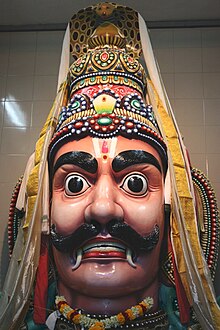
Back إرافان Arabic ইরাবান Bengali/Bangla Iraván Spanish ایراوان Persian Iravan French ઇરવન Gujarati इरावन Hindi Irawan ID Irawan JV ಐರಾವಣ Kannada
| Iravan | |
|---|---|
 Aravan worshipped at Sri Mariamman Temple, Singapore. A cobra hood is sheltering Aravan's head. | |
| Devanagari | इरावान् |
| Sanskrit transliteration | Irāvāṇ |
| Tamil | அரவான் |
| Affiliation | Nāga |
| Weapon | Sword, Bow and Arrows |
| Parents | Ulupi (mother) Arjuna (father) |
| Consort | Krishna in his Mohini form |
Iravan also known as Iravat[1] and Iravant, is a minor character from the Hindu epic Mahabharata. The son of Pandava prince Arjuna (one of the main heroes of the Mahabharata) and the Naga princess Ulupi, Iravan is the central deity of the cult of Kuttantavar (Kuttandavar) which is also the name commonly given to him in that tradition—and plays a major role in the sect of Draupadi. Both these sects are of Tamil origin, from a region of the country where he is worshipped as a village deity and is known as Aravan. He is also a patron god of well-known transgender communities called Alis (also Aravani in Tamil, and Hijra throughout South Asia).[2]
The Mahabharata portrays Iravan as dying a heroic death on the 8th day of the 18-day Kurukshetra War (Mahabharata war), the epic's main subject. However, the South Indian traditions have a supplementary practice of honouring Aravan's self-sacrifice to the goddess Kali to ensure her favour and the victory of the Pandavas in the war. The Kuttantavar tradition focuses on one of the three boons granted to Aravan by the god Krishna in honour of this self-sacrifice. Aravan requested that he be married before his death. Krishna satisfied this boon in his female form, Mohini. In Koovagam, Tamil Nadu, this incident is re-enacted in an 18-day festival, first by a ceremonial marriage of Aravan to Alis (hijra) and male villagers (who have taken vows to Aravan) and then by their widowhood after ritual re-enactment of Aravan's sacrifice.
The Draupadi tradition emphasises another boon: Krishna allows Aravan to witness the entire duration of the Mahabharata war through the eyes of his severed head. In another 18-day festival, the ceremonial head of Aravan is hoisted on a post to witness the ritual re-enactment of the Mahabharata war. The head of Aravan is a common motif in Draupadi temples. Often it is a portable wooden head; sometimes it even has its own shrine in the temple complex or is placed on the corners of temple roofs as a guardian against spirits. Aravan is worshipped in the form of his severed head and is believed to cure disease and induce pregnancy in childless women.
Iravan is also known in Indonesia (where his name is spelled Irawan). An independent set of traditions have developed around Irawan on the main island of Java where, for example, he loses his association with the Naga. Separate Javanese traditions present a dramatic marriage of Irawan to Titisari, daughter of Krishna, and a death resulting from a case of mistaken identity. These stories are told through the medium of traditional Javanese theatre (Wayang), especially in shadow-puppet plays known as Wayang Kulit.
- ^ Sörensen (1902) p. 345 indexes the name as Irāvat.
- ^ Somasundaram O, S (January–March 2009). "Transgenderism: Facts and fictions". Indian Journal of Psychiatry. 51 (1): 73–75. doi:10.4103/0019-5545.44917. PMC 2738402. PMID 19742192.